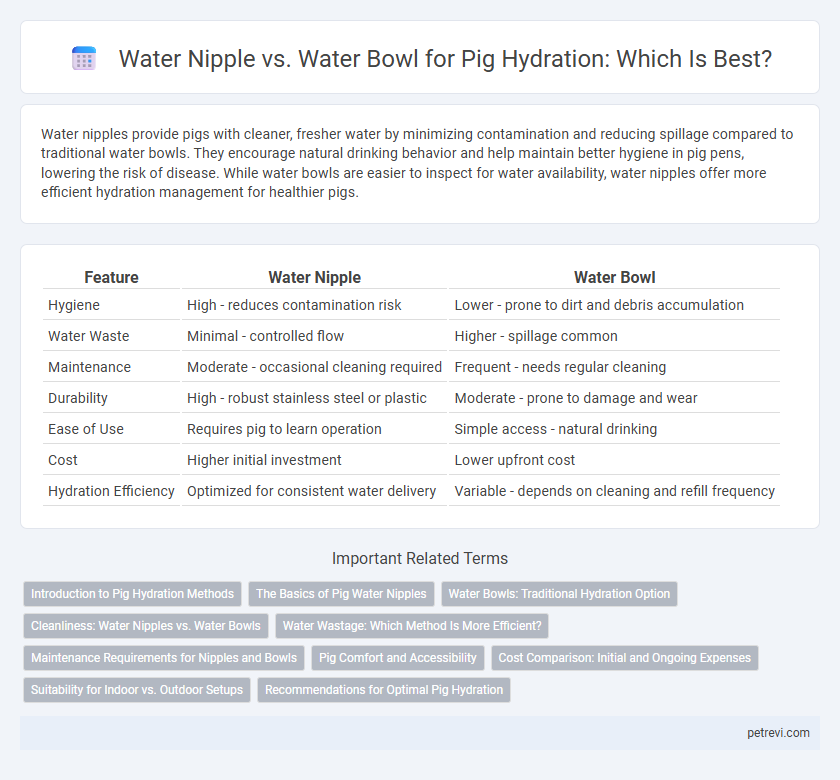Water nipples provide pigs with cleaner, fresher water by minimizing contamination and reducing spillage compared to traditional water bowls. They encourage natural drinking behavior and help maintain better hygiene in pig pens, lowering the risk of disease. While water bowls are easier to inspect for water availability, water nipples offer more efficient hydration management for healthier pigs.
Table of Comparison
| Feature | Water Nipple | Water Bowl |
|---|---|---|
| Hygiene | High - reduces contamination risk | Lower - prone to dirt and debris accumulation |
| Water Waste | Minimal - controlled flow | Higher - spillage common |
| Maintenance | Moderate - occasional cleaning required | Frequent - needs regular cleaning |
| Durability | High - robust stainless steel or plastic | Moderate - prone to damage and wear |
| Ease of Use | Requires pig to learn operation | Simple access - natural drinking |
| Cost | Higher initial investment | Lower upfront cost |
| Hydration Efficiency | Optimized for consistent water delivery | Variable - depends on cleaning and refill frequency |
Introduction to Pig Hydration Methods
Water nipples provide pigs with clean, fresh water on demand, reducing contamination risk compared to traditional water bowls. Water bowls offer a constant water supply but require frequent cleaning to prevent bacterial growth and water spillage. Choosing the right hydration method impacts pig health, growth rates, and overall farm biosecurity.
The Basics of Pig Water Nipples
Pig water nipples provide a hygienic and efficient hydration method by delivering clean water directly to the animal, minimizing waste and contamination. These nipples activate with piglets' natural rooting behavior, ensuring continuous water availability and reducing the need for manual refilling. Compared to water bowls, water nipples lower the risk of bacterial growth and help maintain optimal water intake for healthier, more productive pigs.
Water Bowls: Traditional Hydration Option
Water bowls serve as a traditional hydration option for pigs, providing a simple and cost-effective solution for easy access to water. They require regular cleaning to prevent contamination and maintain water quality, which is crucial for pig health and growth. Compared to water nipples, water bowls offer visible water levels, enabling better monitoring of hydration status in swine.
Cleanliness: Water Nipples vs. Water Bowls
Water nipples significantly reduce contamination risks compared to water bowls by providing a closed, drip-free hydration source for pigs, minimizing the accumulation of dirt, bedding, and feces. Water bowls often require frequent cleaning to prevent algae growth and bacterial buildup that can lead to illness, increasing labor costs and maintenance time. Utilizing water nipples enhances hygiene standards in pig housing, promoting healthier livestock and improving overall farm biosecurity.
Water Wastage: Which Method Is More Efficient?
Water nipples significantly reduce water wastage compared to water bowls in pig hydration systems by delivering a controlled flow that minimizes spillage. Studies show that using water nipples can decrease water loss by up to 40%, promoting sustainability and lowering operational costs on pig farms. Water bowls often lead to contamination and overflow, further increasing water waste and health risks for pigs.
Maintenance Requirements for Nipples and Bowls
Water nipples for pig hydration require regular cleaning to prevent clogging and bacterial buildup, ensuring a consistent water flow. Water bowls demand frequent draining and scrubbing to avoid algae growth and contamination from feed or waste. Both systems benefit from routine inspections, but nipples generally offer lower maintenance costs due to reduced water spillage and cleaner delivery.
Pig Comfort and Accessibility
Water nipples provide pigs with cleaner, fresher water by minimizing contamination, promoting better hydration and overall health. They offer easier accessibility for pigs of varying sizes, reducing water spillage and maintaining a dry, comfortable pen environment. In contrast, water bowls can become dirty quickly, potentially lowering water intake and causing discomfort due to wet bedding and increased risk of bacterial growth.
Cost Comparison: Initial and Ongoing Expenses
Water nipples for pig hydration typically require higher initial costs due to installation and equipment but offer lower ongoing maintenance expenses by reducing water waste and contamination. Water bowls have lower upfront expenses yet incur greater ongoing costs because of frequent cleaning, water spillage, and potential disease spread. Long-term cost efficiency favors water nipples in commercial pig farming operations where durability and hygiene are critical.
Suitability for Indoor vs. Outdoor Setups
Water nipples offer precise control over water flow and are ideal for indoor pig housing where hygiene and water conservation are critical. Water bowls are better suited for outdoor setups, providing easy access for pigs to drink but requiring frequent cleaning to prevent contamination. Selecting the appropriate hydration system depends on environmental conditions and management practices to ensure pig health and hydration efficiency.
Recommendations for Optimal Pig Hydration
Water nipples provide a more hygienic and efficient method for pig hydration by reducing water contamination and spillage compared to water bowls. Optimal pig hydration requires easy access to clean water sources, and water nipples ensure consistent water flow that minimizes waste and supports pig health. For intensive pig farming, installing water nipples with proper height adjustments and regular maintenance is recommended to promote adequate water intake and prevent dehydration.
Water nipple vs Water bowl for Pig hydration Infographic

 petrevi.com
petrevi.com